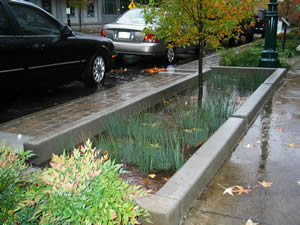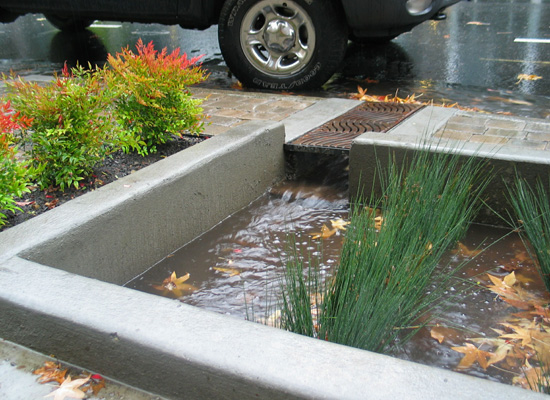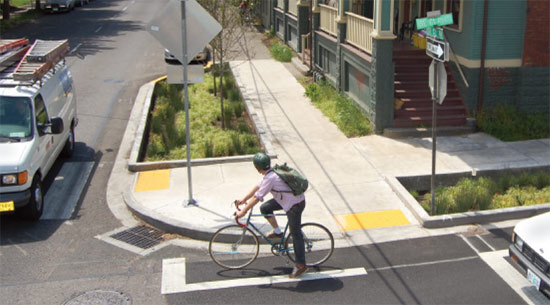

| Stormwater Planters |
|||
| Case studies | |||
Portland, OR (12th Ave Green Street) Plymouth Town Hall (Plymouth, MA)
Maynard Avenue Green Street With the goal to support sustainable development, the project captures rainwater from Nihonmachi Terrace Apartment’s roof and stores the water in a cistern. The rainwater is then pumped to a series of planters by an imported traditional Japanese hand pump, which is mounted on the cistern. As the rainwater moves through the planters it irrigates the plants, which, in turn, filter the remaining water before it flows into the city’s drainage system. The focus of this project is on filtration of rainwater and the quality of it when piped back into the sewer system. The down spout and trench basin feed into the cistern designed for the 2-year storm event. From there, when the hand pump is not being used as irrigation for the plants, the cistern overflows into the first planter bed. The filtration planter has at least 18 inches of growing medium soil, overflow pipe about 4 inches below top of planter, filter fabric, and gravel surrounding a perforated pipe that runs the length of the planter and discharges the water into the next planter bed. This project was a success, and a great example of how something so simple can take a lot of time and planning to accomplish. Some general performance benefits in stormwater planters that relate to this case study are listed. 1. Stormwater Cleansing and Filtering – the amount of cubic feet of stormwater per year that is treated for quality resourcing can be taken into account as a benefit later on. 2. Stormwater Detention – preventing specific volumes of water to enter an over-burdened combined sewer system is key, to prevent future CSO’s. 3. Labor Cost Reduction – by leveraging volunteer hours and landscape stewardship programs in public spaces, costs are reduces elsewhere in the long run. 4. Pedestrian Quality – improved ratings on the Pedestrian Environmental Quality Index (PEQI) create a more desirable public space. 5. Structure – creating this system as a swale or in ground vault feature is simply not possible in some urban and poor soil areas; therefore, the structure of concrete raised beds can be implemented in many different locations. Looking to the future, this stormwater planter street has kick started the Maynard avenue SDOT project that will implement green streets 3 blocks south (Jackson to Dearborn). The City’s proposed Livable Downtown plan, currently under review by City Council, which recommends improving livability in the neighborhood by enhancing and extending green streets. Maynard Ave links important open spaces and community facilities in the neighborhood. Design will be an extension of the existing green street by including a healthy pedestrian-friendly environment, focusing on stormwater treatment and harvesting, and supporting the neighborhood’s existing summer night market program. Overall, it will be a pedestrian improvement project. |
|||
|
|||














